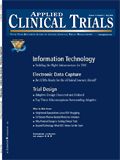Make Room for Change
Applied Clinical Trials
Norbert Clemens, MD, head of clinical development for CRS Clinical Research Services, explains that EDC is more than just technology; it is indeed the new way of thinking about clinical research.
The main obstacle to patient relevant reporting during the development of new drugs is the recommendation for randomized clinical trials (RCT)—the gold standard. Clinical trials complying with this recommendation represent the most scientifically valid study design for evaluating the safety and efficacy of new medical treatments. However, for patient relevant data, the usual pivotal clinical trial may not always represent the appropriate vehicle for generating information on the safety and cost-related issues of medical treatments.

Norbert Clemens, MD
Within this artificial setting, which includes lengthy inclusion and exclusion criteria to maximize therapeutic effect, you cannot obtain any meaningful data concerning safety issues associated with the treatment or concerning cost effectiveness. So, how could one solve this catch-22 situation of RCT versus noninterventional study settings?
The straightforward approach to managing the so-called fourth hurdle (besides quality, efficacy, and safety) is data collection during Phase IIIb studies and in real life settings after marketing authorization (i.e., Phase IV). The real world of patient care offers a substantial number of patient datasets that could be retrieved through a disease or product registry.
Noninterventional data retrieval is one of the most prominent areas for EDC, as easy-to-use solutions allow for the timely collection of data. But be reminded that EDC implementation is not simply a computer system implementation. In fact, EDC technology is only the tool that enables the critical changes that lead to benefits.
On the one hand, it is quite easy for a pharmaceutical company to commit to using EDC as its standard for executing clinical research. On the other hand, however, it is very difficult to understand how to make that commitment a reality. To benefit from EDC systems, everyone involved in clinical research has to modify the way they work—since as clinical research processes change, so too do the underlying roles.
The EDC transition primarily affects data management, site monitoring, and project management (project leaders are responsible for establishing explicit targets for a given EDC project, relative to both timelines and expected benefits). But the role changes will not just affect the core clinical research team; they will also affect everyone involved in the clinical research process.
For example, when using EDC, data management must be involved much earlier in the study cycle. Also, clinical research associates, investigators, and site staff should all expect a shift in workload from a poststudy peak to a steady flow throughout the life cycle of the clinical trial. And prior to implementation, there is the need to develop a customized training program for EDC (e.g., the optimal approach to training for a given team).
In conclusion, EDC is more than just a new technology. It is indeed the new way of thinking about clinical research. The implementation of EDC while maintaining the processes that support a paper-based system is a crucial assignment. The most fundamental prerequisite regarding the success of EDC is change. In other words, all clinical research processes have to be redesigned and all key roles have to be updated to integrate efficiently with the EDC solution. Until this is accomplished, the benefit potential of EDC will not be reached.

Improving Relationships and Diversifying the Site Selection Process
April 17th 2025In this episode of the Applied Clinical Trials Podcast, Liz Beatty, co-founder and chief strategy officer, Inato, discusses a number of topics around site engagement including community-based sites, the role of technology in improving site/sponsor relationships, how increased operational costs are impacting the industry, and more.